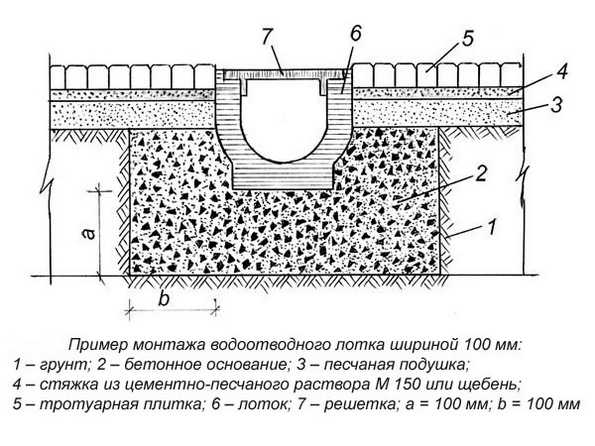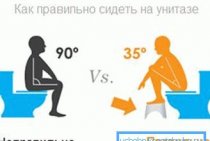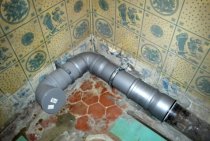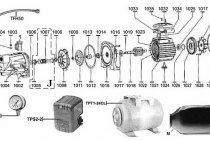Installation rules

plastic trays
Installation of polymer structures is carried out in stages:
- A ditch is dug in accordance with the drawing in the area where the tray product is supposed to be installed.
- A concrete substrate is created by pouring the solution in a uniform layer on the bottom of the ditch.
- Plastic trays are placed in the trench in the center.
- The slopes are poured with concrete to ensure the stability of the drainage structure.
Connect the trays into a single structure end-to-end. For convenience, a tongue is made on one side of the tray, and a groove on the opposite side. For a corner joint, a small hole is cut in the side wall and the products are joined at an angle of 90 degrees, sealed and a plug is installed.
Fix the grate on the plastic tray as follows:
- The main fastening system is installed in the tray element by unscrewing the bolt from it.
- Fasten the hardware into the groove on the lattice part.
- Tighten the screw - firmly, until it stops.
The stamped lattice is fixed quite simply: the locks are bent along the edges and the part is fixed in the tray.
Concrete trays
 Products are produced both with a rectangular and a round inner surface (for example, variants of the Aquastock brand). The latter better pass wastewater. The installation of both of them is carried out according to the same scheme.
Products are produced both with a rectangular and a round inner surface (for example, variants of the Aquastock brand). The latter better pass wastewater. The installation of both of them is carried out according to the same scheme.
Tray structures are installed in a previously dug trench on a concrete pad. The thickness of the layer is determined depending on the degree of loading. The base is usually created from B25 concrete. The fastening of the sides is performed in the form of slopes.
Reinforced concrete trays are joined to each other and sealed. With the corner connection of the drainage system, the necessary part of the side wall is cut out.
In the direction of the drainage line, thermal seams are formed by notches at a distance of 20 mm from each other to prevent deformation of the system during seasonal temperature changes.
Lattices fasten to concrete by means of special screws. They can be removed for cleaning. The top of the installed lattice part must necessarily be 0.5 cm below the level of the coating surface.
It is best to connect the tray chain to the sewer lines through a sand trap. The pipeline from it to the first well is performed using a pipe segment with a socket and smooth walls.
The correct selection of grating elements and their strong fixation to the trays are important for road safety. A vehicle passing even at low speed is quite capable of knocking out a loose grate, creating an emergency.
https://youtube.com/watch?v=3PLpdSC9FlI
Purpose of drainage gratings
 Storm trays with gratings
Storm trays with gratings
Arrangement of storm water and drainage is possible with the help of drainage trays to drain excess moisture. For their manufacture, concrete, metal and polymers with a smooth surface are used. When installing tray structures at an angle, a uniform flow of excess water is ensured even after prolonged downpours. They cover the devices with special gratings that can prevent branches, leaves and other debris from entering the sewer.
Lattice parts also have additional functions:
- Safety. By closing the drainage cavity, they make it possible to avoid inadvertent injuries to people and animals.
- Creation of unimpeded traffic. Drainage grids laid flush with the road surface allow vehicles to maneuver and withstand significant loads.
- Improvement of the territory - the street or a personal plot.
Production material
Lattice products are subdivided according to the material of manufacture. The scope of the parts also depends on it:
- Cast iron elements are used for most of the linear type drainage systems, which are installed in areas with constant friction and high pressure.
- Stainless steel metal gratings are used at large gas stations, roadsides, near industrial plants and in locations where there are high requirements for the anti-corrosion characteristics of the material. To reduce the cost of summing up storm sewers, galvanized steel is sometimes used.
- Plastic gratings are used in places with minor loads: in personal plots, paths for pedestrians, parks and squares. They are not allowed to be installed on roads with a dense flow of freight transport.
- Copper products are able to withstand only a small load and are used as decoration.
Types and sizes
In terms of dimensions and shape, the lattice parts must correspond to the trays they cover. The size of the gratings depends on the width of the hydraulic section of the tray element and is indicated in the marking: from DN95 to DN500. The standard length of the tray is 1 m, although they are also more elongated. Width - in the range of 14–400 cm.
Grates for storm sewer systems are divided according to the load class:
| Class | Load (t) | purpose | Popular Models |
| A | up to 1.5 | Mounted on home gardens and paths for pedestrians. | Plastic storm, stamped galvanized steel, copper water intake, stamped stainless steel. |
| B | up to 12.5 | Used in car parks, car parks. | Cellular steel galvanized. |
| WITH | up to 25 | Installed on highways or gas stations. | Stamped stainless steel, cast iron slotted and cellular. |
| D | up to 40 | Able to hold the weight of a truck and are placed on routes where such vehicles are allowed to pass. | Cast iron slotted and cellular. |
| E | up to 60 | Are established on parkings of cargo motor transport, terminals, warehouses. | |
| F | up to 90 | They are used at airports, military bases, in areas where heavy special equipment is moving. |
The latter type is rarely used and only in places with an extremely high load on the road surface.


